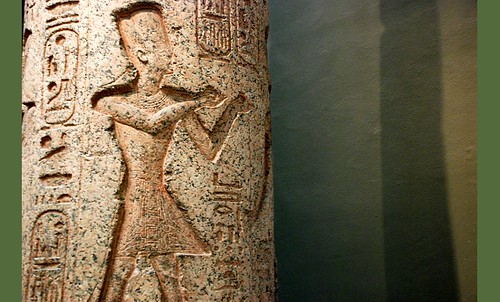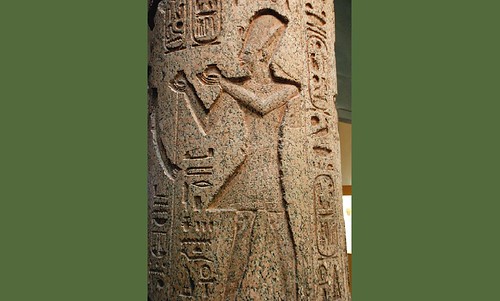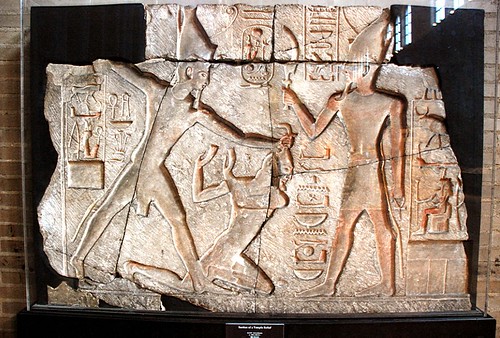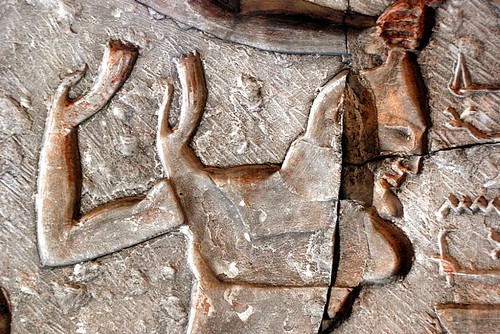
Cargado el 5 de noviembre, 2009
Galería de Hans Ollermann
King Ramses II (also called Ramses the Great) 1279-1212 B.C.

2007_0725_191554AA
Palm column.
From Heracleopolis.
Dynasty 5, 2524-2250 B.C. and
reused in Dynasty 19 , 1293-1185 B.C.
Red granite.
While the inscriptions on this palm capital column were cut by king Ramesses II and Merneptah in Dynasty 19, the column itself was reused from a much older structure,
possibly a temple , associated with a pyramid in Sakkara or Abusir.
Museum of Fine Arts (MFA), Boston.

2007_0725_191518AA
Palm column.
From Heracleopolis.
Dynasty 5, 2524-2250 B.C. and
reused in Dynasty 19 , 1293-1185 B.C.
Red granite.
While the inscriptions on this palm capital column were cut by king Ramesses II and Merneptah in Dynasty 19, the column itself was reused from a much older structure,
possibly a temple , associated with a pyramid in Sakkara or Abusir.
Museum of Fine Arts (MFA), Boston.

2007_0725_191542AA
Palm column.
From Heracleopolis.
Dynasty 5, 2524-2250 B.C. and
reused in Dynasty 19 , 1293-1185 B.C.
Red granite.
While the inscriptions on this palm capital column were cut by king Ramesses II and Merneptah in Dynasty 19, the column itself was reused from a much older structure,
possibly a temple , associated with a pyramid in Sakkara or Abusir.
Museum of Fine Arts (MFA), Boston.
Comentarios
Ryan Chatfield dice:
Hi, I'm an admin for a group called Heritage Key, and we'd love to have this added to the group!

2007_0727_163007AA
Section of a temple-relief from Tell el-Retaba,Egypt.
Ramesses II slaying an Asiatic enemy. His missing right arm probably held a mace. The god Atum offers the king the sword of victory in exchange for the ritual sacrifice of the captive.
Dynasty 19. Limestone.
University of Pennsylvania Museum, Philadelphia.

2007_0727_163021AA
Section of a temple-relief from Tell el-Retaba,Egypt.
Ramesses II slaying an Asiatic enemy. His missing right arm probably held a mace. The god Atum offers the king the sword of victory in exchange for the ritual sacrifice of the captive.
Dynasty 19. Limestone.
University of Pennsylvania Museum, Philadelphia.

2007_0727_163027AA
Section of a temple-relief from Tell el-Retaba,Egypt.
Ramesses II slaying an Asiatic enemy. His missing right arm probably held a mace. The god Atum offers the king the sword of victory in exchange for the ritual sacrifice of the captive.
Dynasty 19. Limestone.
University of Pennsylvania Museum, Philadelphia.
Intef IV
De Wikipedia, la enciclopedia libre
Sehetepkara Intef, o Intef IV, fue un faraón de la dinastía XIII de Egipto que reinó cerca de 1710 a. C.[1]
Este gobernante figura en un fragmento del Canon Real de Turín como ...ka...Intef, en el registro VI,22.
Testimonios de su época [editar]
El nombre de este soberano está inscrito en la base de una estatua, procedente de Medinet Maadi (El Fayum), depositada en el Museo de El Cairo, y varios escarabeos.
Titulatura [editar]
| Titulatura | Jeroglífico | Transliteración (transcripción) - traducción - (procedencia) |
| Nombre de Nesut-Bity: |
| s ḥtp rˁ (Sehetepra) El que satisface al Ka de Ra (Medinet Madi) |
| Nombre de Sa-Ra: |
| in t.f (Intef) Intef (Medinet Madi) |
| Nombre de Sa-Ra: |
| ...k3... in t.f (...ka... Intef) ...ka... Intef (Canon Real de Turín nº 6,22) |
Referencias [editar]
- Notas
- ↑ Krauss, y Franke.
- Referencias digitales
- http://www.narmer.pl/dyn/13en.htm (en inglés)
| Predecesor: Imiramesha | Faraón Dinastía XIII | Sucesor: Set I |
Anjotef IV.
aus Wikipedia, der freien Enzyklopädie
| Namen von Anjotef IV. | ||||||||||||||||
|---|---|---|---|---|---|---|---|---|---|---|---|---|---|---|---|---|
| Eigenname |
Jnj jt=f Der seinen Vater mitbringt | |||||||||||||||
| Thronname |
Sḥtp-k3-Rˁ Mit zufriedengestelltem Ka, ein Re | |||||||||||||||
Anjotef IV., auch Antef IV. oder Intef IV. war ein altägyptischer König (Pharao) der 13. Dynastie (Zweite Zwischenzeit). Er regierte um 1710 v. Chr.[1]
Belege [Bearbeiten]
Anjotef IV. ist nur vom Turiner Königspapyrus (6.22) sowie Skarabäen und einer Statue bekannt, die man in Medinet Madi fand. Er gilt als 19. Herrscher der 13. Dynastie.
Literatur [Bearbeiten]
- Jürgen von Beckerath: Untersuchungen zur politischen Geschichte der zweiten Zwischenzeit in Ägypten. Glückstadt 1964, S. 52–53
- Detlef Franke: Zur Chronologie des Mittleren Reiches. (Orientalia 57)
Einzelnachweise [Bearbeiten]
- ↑ Datierung nach Rolf Krauss in: Thomas Schneider: Lexikon der Pharaonen.
| Vorgänger | Pharao von Ägypten 13. Dynastie | Nachfolger |
| Personendaten | |
|---|---|
| NAME | Anjotef IV. |
| ALTERNATIVNAMEN | Anjotef; Antef; Intef; Sehotep-ka-Rê |
| KURZBESCHREIBUNG | altägyptischer König der 13. Dynastie |
| GEBURTSDATUM | 18. Jahrhundert v. Chr. |
| STERBEDATUM | 18. Jahrhundert v. Chr. oder 17. Jahrhundert v. Chr. |


![S29 [s] s](http://es.wikipedia.org/w/extensions/wikihiero/img/hiero_S29.png)

![X1 [t] t](http://es.wikipedia.org/w/extensions/wikihiero/img/hiero_X1.png)
![Q3 [p] p](http://es.wikipedia.org/w/extensions/wikihiero/img/hiero_Q3.png)



![I9 [f] f](http://es.wikipedia.org/w/extensions/wikihiero/img/hiero_I9.png)



![M17 [i] i](http://es.wikipedia.org/w/extensions/wikihiero/img/hiero_M17.png)

![W25 [ini] ini](http://de.wikipedia.org/w/extensions/wikihiero/img/hiero_W25.png)
![X1 [t] t](http://de.wikipedia.org/w/extensions/wikihiero/img/hiero_X1.png)
![I9 [f] f](http://de.wikipedia.org/w/extensions/wikihiero/img/hiero_I9.png)


![N5 [ra] ra](http://de.wikipedia.org/w/extensions/wikihiero/img/hiero_N5.png)
![R4 [Htp] Htp](http://de.wikipedia.org/w/extensions/wikihiero/img/hiero_R4.png)
![Q3 [p] p](http://de.wikipedia.org/w/extensions/wikihiero/img/hiero_Q3.png)
![D28 [kA] kA](http://de.wikipedia.org/w/extensions/wikihiero/img/hiero_D28.png)
